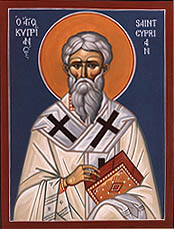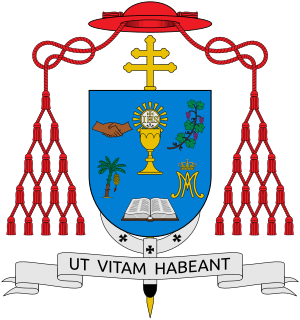Related Research Articles

Canonization is the declaration of a deceased person as an officially recognized saint, specifically, the official act of a Christian communion declaring a person worthy of public veneration and entering their name in the canon catalogue of saints, or authorized list, of that communion's recognized saints.

Óscar Arnulfo Romero y Galdámez was a prelate of the Catholic Church in El Salvador. He served as auxiliary bishop of the archdiocese of San Salvador, the titular bishop of Tambeae, as bishop of Santiago de María, and finally as the fourth archbishop of San Salvador. As archbishop, Romero spoke out against social injustice and violence amid the escalating conflict between the military government and left-wing insurgents that led to the Salvadoran Civil War. In 1980, Romero was shot by an assassin while celebrating Mass. Though no one was ever convicted for the crime, investigations by the UN-created Truth Commission for El Salvador concluded that Major Roberto D'Aubuisson, founder of the right-wing Nationalist Republican Alliance (ARENA) political party, had ordered the killing.

Philomena, also known as Saint Philomena, was a young consecrated virgin whose remains were discovered on May 24–25, 1802, in the Catacomb of Priscilla. Three tiles enclosing the tomb bore an inscription, Pax Tecum Filumena, that was taken to indicate that her name was Filumena, the English form of which is Philomena. Philomena is the patron saint of infants, babies, and youth.

In the Catholic Church, the Congregation for the Causes of Saints is the congregation of the Roman Curia that oversees the complex process that leads to the canonization of saints, passing through the steps of a declaration of "heroic virtues" and beatification. After preparing a case, including the approval of miracles, the case is presented to the pope, who decides whether or not to proceed with beatification or canonization. This is one of nine Vatican Curial congregations.

Doctor of the Church, also referred to as Doctor of the Universal Church, is a title given by the Catholic Church to saints recognized as having made a significant contribution to theology or doctrine through their research, study, or writing.

Charles Lwanga was a Ugandan convert to the Catholic Church who was martyred with a group of his peers and is revered as a saint by both the Catholic Church and the Anglican Communion.

On May 21, 2000, Pope John Paul II canonized a group of 25 saints and martyrs who had died in the Mexican Cristero War. The vast majority are Catholic priests who were executed for carrying out their ministry despite the suppression under the anti-clerical laws of Plutarco Elías Calles after the revolution in the 1920s. Priests who took up arms, however, were excluded from the process. The group of saints share the feast day of May 21.

José Luis Sánchez del Río was a Mexican Cristero who was put to death by government officials because he refused to renounce his Catholic faith. His death was seen as a largely political venture on the part of government officials in their attempt to stamp out dissent and crush religious freedom in the area. He was dubbed "Joselito."

The Forty Martyrs of England and Wales are a group of Catholic, lay and religious, men and women, executed between 1535 and 1679 for treason and related offences under various laws enacted by Parliament during the English Reformation. The individuals listed range from Carthusian monks who in 1535 declined to accept Henry VIII's Act of Supremacy, to seminary priests who were caught up in the alleged Popish Plot against Charles II in 1679. Many were sentenced to death at show trials, or with no trial at all.

Ambrose Edward Barlow, O.S.B., was an English Benedictine monk who is venerated as a saint in the Catholic Church. He is one of a group of saints canonized by Pope Paul VI who became known as the Forty Martyrs of England and Wales.

Devasahayam Pillai, known as Lazarus his baptismal name, is a beatified Indian layman of the Catholic Church Latin Rite. Born into a Hindu family in the 18th century, he converted to Catholicism and is considered a martyr of the Christian faith. Pillai was an official in the court of the King of Travancore, Maharaja Marthanda Varma, when he came under the influence of Dutch naval commander, Captain Eustachius De Lannoy, who instructed him in the Catholic faith. He is believed to have been killed by the Travancore state for upholding his Christian faith.

Saints Victor and Corona are two Christian martyrs. Victor was a Roman soldier who was tortured and killed; Corona was killed for comforting him. Corona is invoked as a patron of causes involving money; she was not historically associated with pandemics or disease, but has been invoked against the coronavirus pandemic.
The Martyrs of the Spanish Civil War are the Catholic Church's term for the people killed by Republicans during the Spanish Civil War for their faith. More than 6,800 clergy and religious were killed in the Red Terror. As of February 2022, 2,069 Spanish martyrs have been beatified; 11 of them being canonized. For some 2,000 additional martyrs, the beatification process is underway.

Inocencio of Mary Immaculate , born Emanuele Canoura Arnau, was a member of the Passionist Congregation and was killed during the Asturias revolt. He and his companions are known collectively as the Martyrs of Turon. He was canonised by Pope John Paul II in 1999.

The 498 Spanish Martyrs were victims of the Spanish Civil War beatified by the Roman Catholic Church in October 2007 by Pope Benedict XVI. It was the greatest numbers of persons ever beatified at once up to that time in the Church's history. They originated from many parts of Spain. Their ages ranged from 16 years to 78 years old. Although almost 500 persons, they are a small part of the Martyrs of the Spanish Civil War.
The martyrs of Turon were a group of eight members of the Catholic, religious-teaching congregation Institute of the Brothers of the Christian Schools, also known as De La Salle Brothers, and one Passionist priest who were executed by insurrectionists in Spain, during the Asturias uprising of October 1934. They were canonized in 1999 by Pope John Paul II.

The Personal Ordinariate of the Chair of Saint Peter is a personal ordinariate in the Latin Church of the Catholic Church for priests and laypeople from an Anglican background, that enables them to retain elements of their Anglican patrimony after entering the Catholic Church. Its territory extends over the United States and Canada. The personal ordinariate is immediately exempt to the Holy See. Former Methodists and former members of communions of "Anglican heritage" such as the United Church of Canada are also included. The liturgy of the ordinariates, known as the Anglican Use, is a form of the Roman Rite with the introduction of traditional Anglican elements.

Antoine Kambanda is a Rwandan prelate of the Catholic Church who has been Archbishop of Kigali since January 2019. He had been Bishop of Kibungo from 2013 to 2018.

David Roldán Lara was a Mexican layman who was killed during the Cristero War. A pro-Catholic activist during the anticlerical period under President Plutarco Elías Calles, he was captured by government forces, and was executed for refusing to renounce his position. Roldán was canonized by Pope John Paul II on 21 May 2000 as one of 25 Martyrs of the Cristero War.

Saint Adbiesus was a Deacon who was one of the Martyrs of Persia under Shapur II.
References
- ↑ "Saint Acestes". June 29, 2010. Archived from the original on October 29, 2019. Retrieved February 21, 2020.
- ↑ Online, Catholic. "St. Acestes - Saints & Angels". Catholic Online. Archived from the original on 2019-07-01. Retrieved 2020-02-21.